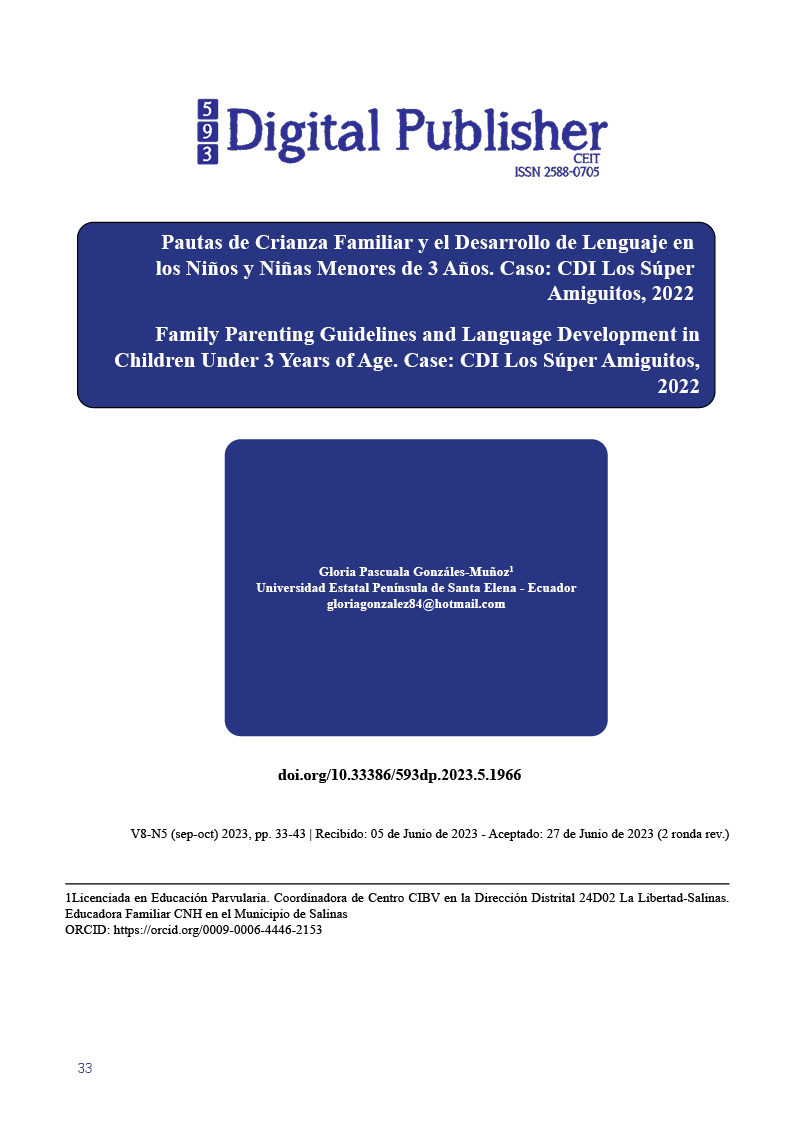Guidelines for family upbringing and language development in children under 3 years of age. Case of the Child Development Center CDI Los Súper Amiguitos, 2022.
Main Article Content
Abstract
The guidelines of family upbringing in the development of language in children under three years of age is a descriptive investigation, since the hypothesis is based on the influence that the SARS Covid-19 pandemic had in 2020 so that children who were in the CDI "Centro de Desarrollo Infantil Los super amiguitos" have language development problems, for the verification of hypotheses it has been decided to use the survey as a research instrument with quantitative methodology, being the data analysis by means of tabulation the study results analysis tool. When delving deeper into the issue of family upbringing guidelines, it is denoted that parents are the main agents of development so that children grow up with values and conduct in accordance with what society asks of them, however, rapid social changes make it difficult the teaching-learning process that is implemented from the first months of the newborn's life and gradually over the years, even more so in rural environments where the lack of quality education is evident.
Downloads
Article Details

This work is licensed under a Creative Commons Attribution-NonCommercial-ShareAlike 4.0 International License.
1. Derechos de autor
Las obras que se publican en 593 Digital Publisher CEIT están sujetas a los siguientes términos:
1.1. 593 Digital Publisher CEIT, conserva los derechos patrimoniales (copyright) de las obras publicadas, favorece y permite la reutilización de las mismas bajo la licencia Licencia Creative Commons 4.0 de Reconocimiento-NoComercial-CompartirIgual 4.0, por lo cual se pueden copiar, usar, difundir, transmitir y exponer públicamente, siempre que:
1.1.a. Se cite la autoría y fuente original de su publicación (revista, editorial, URL).
1.1.b. No se usen para fines comerciales u onerosos.
1.1.c. Se mencione la existencia y especificaciones de esta licencia de uso.
References
Ares, P. (2002) Psicología de la Familia. Una Aproximación a su Estudio. La Habana: Editorial Félix Varela.
Canto, R. (2017). Revista de Ciencias sociales. Obtenido de Participación ciudadana, pluralismo y democracia: https://www.scielo.org.mx/pdf/tla/v10n41/1870-6916-tla-10-41-00054.pdf
Cuervo, A. (2015). Pautas de crianza y desarrollo socioafectivo en la infancia. Diversitas. Obtenido de https://www.redalyc.org/pdf/679/67916261009.pdf
De La Cadena, Y. (2018). Prácticas de crianza en la familia para el desarrollo del lenguaje en niños de 18 meses de edad. Obtenido de http://dspace.casagrande.edu.ec:8080/bitstream/ucasagrande/1363/1/Tesis1559%20CADp.pdf
Goleman, D. (1997). La Inteligencia Emocional. Barcelona: Kairós.
Navarrete, L. (2011). Estilos de crianza y calidad de vida en padres de preadolescentes que presentan conductas disruptivas en el aula. UNIVERSIDAD DEL BÍO-BÍO. http://repobib.ubiobio.cl/jspui/bitstream/123456789/2110/1/Navarrete_Acuna_Lucia.pdf
Ortiz, D. Ruperti, E. Cortez, M & Varas, A. (2020). Lenguaje y comunicación componentes importantes para el desarrollo del bienestar infantil. Horizontes Revista de Investigación en Ciencias de la Educación, 4(16), 450-460. Recuperado en 19 de junio de 2023, de http://www.scielo.org.bo/scielo.php?script=sci_arttext&pid=S2616-79642020000400008&lng=es&tlng=es.
Pacheco, M & Osorno, G. (2021). Incidencia de competencias parentales en el desarrollo de habilidades sociales en hijos únicos. Interdisciplinaria, 38(1), 101-116. https://dx.doi.org/10.16888/interd.2021.38.1.7
Vega, M. (2006) Estilos de crianza y sus efectos. Taller para padres, Instituto Alemán de Valdivia.
Vergara Hernandez, Liliana. (2017). Prácticas de crianza en la primera infancia en los municipios de Riosucio y Manzanares. Zona Próxima, (27), 22-33. https://doi.org/10.14482/zp.27.10980
Villena, M. (2019). LOS ESTILOS DE CRIANZA Y SU RELACIÓN CON EL DESARROLLO DEL LENGUAJE EN NIÑOS DE 3 A 6 AÑOS. UNIVERSIDAD TÉCNICA DE AMBATO.
https://repositorio.uta.edu.ec/bitstream/123456789/30303/2/tesis%20final%20Michelle%20Villena.pdf


